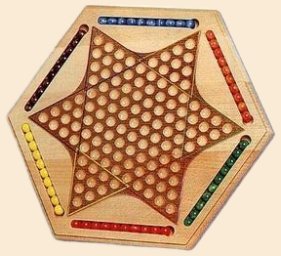

Pieces can jump other pieces occupying adjacent spaces, including the pieces of the player taking a turn. A player moves one piece one space in any direction. The rules of the game say that a coin toss decides who begins, but the players can decide by themselves. Four players use 13 pieces, placed in each corner. When there are 2 players, 19 marbles are put into opposite corners, stacked evenly. When playing three people, leave a star point between each person, and it’s a free-for-all. Each player must have an opponent opposite, so there can only be two, three, four, or six players. Choose ten marbles of one color and place them all on the star point that matches the color of the marbles. The board’s hexagonal interior has five holes on each side. Each triangular star point has ten holes (four holes per side) for a player’s pieces. The six-pointed star board has small dimples or holes, for marbles and pegs, respectively. The game is a mixture of chess, checkers, and Othello, and can have two, three, four, or six players at a time. Chinese Checkers is still called Halma in many European counties. It soon became Chinese Checkers, reflecting the American interest in all things Oriental after the introduction of Mah Jongg and the discovery of King Tut’s tomb. Chinese Checkers was first released in 1928, and was named Hop Ching Checkers. Halma followed the rules of Chinese checkers, but was played on a square board. Another thinks is it a descendent of a German-American game call Stern-Halma. One group thinks it comes from a British game called “hoppity”. It is played with pieces (either marbles or pegs) on a six-pointed star board with holes or dimples for the pieces. He is then declared the winner.Chinese checkers is neither Chinese nor checkers. The game is over when a player has moved all of his pieces into the point opposite where he began. All pieces stay on the board throughout the game.ħ.

Jumping over an opponent's piece does not capture it. Further jumps may optionally be made by this piece in the same turn, to whatever number the player pleases, while the piece is in a position to do so.Ħ. a piece may jump over a single adjacent piece of any colour, in any of the six directions, into the empty space beyond. a piece may be moved to an adjacent playing space. A player takes his turn by moving one of his pieces in one of the following ways: (i). Play then moves clockwise around the board.ĥ. Players decide, at random or by agreement, who takes the first turn. Six players occupy every point of the star.Ĥ. When two play, they start opposite one another three players occupy alternate points of the star so that no player starts directly opposite another four players occupy positions in which each player is opposite another. Each player starts with ten pieces, arranged in one of the points of the star.ģ. Chinese checkers is played on a star-shaped board, of 121 points.Ģ. As the game is neither a variant of checkers nor is it Chinese, this is a fine example of the irony of commercial marketing! In the United States this game became Chinese checkers. This had a star-shaped board, rather than the square board of halma, but the rules were largely unchanged. In 1892 another variant was published in Germany, called Stern-Halma. In 1948 a variant called grasshopper was published, allowing play with a standard draughts set. An 18th century gaming board marked out like a halma board suggests it may have earlier origins, but it was not until the 1880s that it was published and came to the attention of the wider world. The game of halma, whose name means "jump" in Greek, is an entertaining product of the Victorian era.

History of Halma, Grasshopper and Chinese Checkers It is in the construction of long "ladders" of pieces that may be jumped that a player gets ahead in the game. Pieces move to adjacent spaces, but may also jump over one another like in draughts (though without capturing). Players race their pieces from their starting positions, across the board to the opposite end. Unlike most race games, performance is dictated completely by skill rather than any luck element. Chinese checkers, made by Jaques of London.Ĭhinese checkers is a race game for two, three, four or six players.


 0 kommentar(er)
0 kommentar(er)
